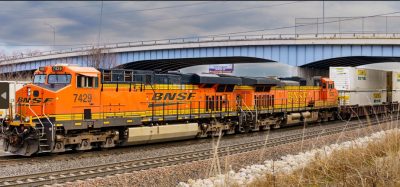Improving level crossing safety
Posted: 26 September 2009 | | No comments yet
Each year in Europe, the number of victims from accidents at level crossings (LCs) is approximately 600. It is a disturbing number, which not only demonstrates that this is a problem affecting all countries, but should also prompt awareness and education campaigns on the rules and good practices when crossing LCs, given that 95% of the recorded accidents resulted from failure to obey the rules.
Each year in Europe, the number of victims from accidents at level crossings (LCs) is approximately 600. It is a disturbing number, which not only demonstrates that this is a problem affecting all countries, but should also prompt awareness and education campaigns on the rules and good practices when crossing LCs, given that 95% of the recorded accidents resulted from failure to obey the rules.
Each year in Europe, the number of victims from accidents at level crossings (LCs) is approximately 600. It is a disturbing number, which not only demonstrates that this is a problem affecting all countries, but should also prompt awareness and education campaigns on the rules and good practices when crossing LCs, given that 95% of the recorded accidents resulted from failure to obey the rules.
It is important to exchange experiences and best practices, to understand what each country is developing in this area and the results accomplished, as well as all stakeholders: the managers of road networks and railways, rail operators, associations and representatives of the automobile industry, the security forces and society at large to engage vigorously in combating this scourge.
In Portugal, the strong growth in road traffic recorded from the 1980s and the increasing speed of trains have significantly raised the risk of crossing the railway, so it became necessary to create conditions intended to reduce the number of accidents.
In 1999, the Portuguese rail network, with 2,794km of active line, had 2,494 level crossings, with an annual average of 151 accidents between 1995 and 1999 that resulted in 35 FWIs (Fatalities and Weighted Injuries).
In December 1999, a new law on rules and regulations of level crossings was published, which, among other things, created the following policies:
- Prohibition to establish new level crossings – all new rail crossings will be over or under passages
- Determines that the rail network manager and the managers of road networks which have level crossings draw up plans for closure of the high risk ones
- Determines the closure of level crossings that have an alternative crossing less than 700m away
- Determines the installation of protective equipment, according to road and rail traffic
It was then decided to develop a ‘plan of closures’ of level crossings in order to achieve an average density of 0.5 LCs/km in 2006 – considered to be the reference value at European level – in late 1999 the density was 0.89 LCs/km.
An extensive programme of closures of level crossings was developed, and at the end of 2004, on 2,818km of active line, the figure had dropped to 1,476 level crossings, which corresponded to a density of 0.52 LCs/km, foreseeing that the target would be achieved during 2005.
In parallel, some 300 level crossings were also upgraded by increasing the degree of protection. In 2004, 102 accidents were recorded that resulted in 28 FWIs. However, the reduction in the number of accidents fell short of expectations, and it was then decided to redefine the goal. The reduction of accidents became the main goal, and a target decrease of 50% in the number of accidents over the figures registered in 2004 was set for 2009.
It was also important to achieve a greater involvement of managers of road networks, since that the bulk of closures and upgrades of level crossings were made by REFER, so negotiation procedures started with those entities for the establishment of partnerships and protocols.
An approach based on risk analysis allowed taking direct actions over the highest risk ones, highlighting, in addition to a continued programme of closures, the following measures:
- Upgrade with half-barrier level crossings with only automatic lights and bells
- Rail signalling forcing train drivers to use the horn when approaching an unprotected level crossing
- Removal of obstacles (trees, earth moving, etc) in order to increase the sight distance on unprotected level crossings with only a St. Andrews Cross
- Increasing the number of automatic half-barrier level crossings
REFER’s systematic approach over the past nine years allowed to halve the number of level crossings, mainly by the construction of approximately 500 over/under passages and more than 700 alternative routes, as well as upgrading 562 level crossings, with a total investment of €269 million.
Of the 1,229 level crossings at the end of 2008, approximately 40% had active protection, when in 1999 they represented only 26%.
In consequence, there was a gradual reduction in casualties, and in 2008, 551 accidents were registered that resulted in 18 FWIs. Of these accidents, 17 occurred at level crossings equipped with active protection equipment, showing that safety equipment alone will not exclude the possibility of accidents occurring.
The reduction of accidents at level crossings remains a fundamental objective for REFER and a new goal of having less than 29 accidents has been set for 2015.
Although the chosen path has achieved positive results, it is also clear that the targets set are challenging. Thus, given that:
- The highest risk level crossings are now mainly situated in heavy urban areas, making the options for closure complex, expensive and difficult to carry out
- Stress and urban expansion are new social risk factors
- The increases in road and rail traffics are potential risk drivers
It will be necessary to implement other measures to reach the targets set.
A strategy based on a new risk model, as well as a new approach to awareness and education campaigns on deterrents are factors that are considered key in this process.
REFER contracted an international consultant specialising in risk assessment of level crossings which, after identifying risk factors inherent for each type of level crossing, is now developing a computer model in order to help evaluate mitigating measures and to define priorities for investment. Therefore, the decision on what type of action to take on a level crossing will be based on consistent criteria.
The integrated approach and the involvement and cooperation of other institutions are proving to be decisive in the success of this new strategy, mainly through:
- Maintenance of governmental incentives to implement the actions planned
- Partnerships with managers of road networks to ensure their support to investment
- Create a set of rules along with the managers of road networks to ensure appropriate conditions in the areas and roads approaching the level crossings
- Review of legislation to allow the imposition of fines if the offense is detected by video systems
- Research and development of new technological solutions in cooperation with universities and the industry
- Involvement of communities neighbouring to the railways, associations, schools and others in awareness and education campaigns about safe behaviour at railway crossings
The 25th June 2009 marked the European level crossing awareness day – an event which Portugal joined. To mark the date, REFER promoted an event where, in addition to signing the European Road Safety Charter, with specific goals in reducing accidents at level crossings, presented the Portuguese ‘Campaign for Awareness at Level Crossings’ and the ‘Level Crossings Safety Green Paper’.
Pare, Escute e Olhe! (Stop, Look and Listen!) is the motto for this campaign and is aimed at raising awareness of users of level crossings that their behaviour is crucial in preventing accidents.
The Green Paper, which during the fourth quarter of 2009 will be subject to public consultation, hopes to broaden the debate on this issue, gathering input and suggestions from the civil society, institutions, researchers, businesses, etc, for solving this problem.
Specific projects
Vouga Line’s Project/Automatic Level Crossing – Low-cost
The Vouga Line, a regional service route built with metric gauge, has 156 level crossings and is 96km long. The number of accidents at level crossings on this line represents approximately 30% of the national total, so REFER decided to develop a specific plan for its reduction.
This Project, which is being developed in partnership with local authorities, includes the closure of approximately 50 level crossings and the automation of 80. The intention of this plan is to obtain a 70% reduction in the number of accidents by the end of 2011, with reference to the year 2006. The goal to be achieved is less than nine accidents at the end of 2011, in contrast to the 27 recorded in 2006.
Given the characteristics of this line, for example low speed (maximum of 50km/h), high density of level crossings, fibre optics throughout the total length of the line and homogeneous rolling stock, the automation of level crossings will make use of a technological solution, already implemented by REFER. Using the optical fibre network for data transfer and communications, and ensuring the fail safe of the level crossings at all times, will allow for a reduction of investment and maintenance costs of approximately 40%, compared to the standard solution of automation.
Obstacle detection system
Installation of this pilot system for detecting obstacles (making use of radar technology) is complemented by fitting double half-barriers and a combination of technologies which aim at stopping some users ‘zig-zagging’ around the barriers and ensures the safety of rail traffic.
Other technologies for obstacle detections are currently under review, including video, laser and induction loops.
Remote control level crossings
Wishing to provide protective equipment for some level crossings located on lines with low road traffic, a low cost solution was researched with electrical control gates that are permanently closed. This system, which uses the fibre optics communication network, allows the user to communicate with REFER’s Operations Command Centre (OCC), which has oversight of the line section, and request the opening of the gates. The operator of the OCC remotely opens the gates, if the train operations and other safety conditions would permit.
Given that the level crossing has video surveillance, as soon as the user has safely crossed the line, the operator can then safely close the gates. The system then recognises that the gates are closed, which is a condition necessary for train operations without restrictions. This pilot system is currently in a test phase on a level crossing on the Douro Line and implementation on other level crossings is expected to occur during the first half of 2010.
Green numbers on Automatic Level Crossings
All level crossings have been equipped with an information board with a free phone number for which users should call in an emergency. This free system allows the user to communicate with the person responsible for the line’s section in the OCC. Since each phone number is unique and corresponds to a specific level crossing, the system identifies where the call is coming from, which in turns allows for a fast response in the case of an emergency.
Reference
- Of these, 22 are significant accidents, according to ERA’s classification








